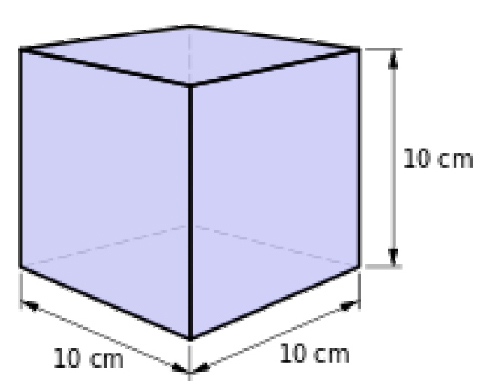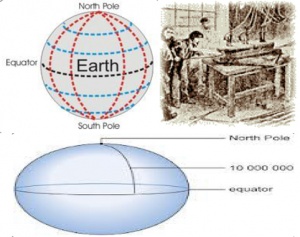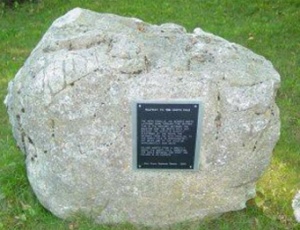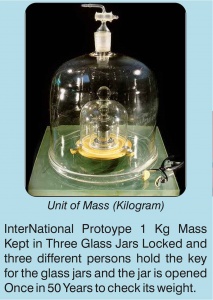We all talk about Weight and day in day out we get involved in Weight Transaction some where or other, like the examples given below [ There are many many to mention just a few given below]
- Vegetables
- Groceries includes Rice, Wheat, Pulses..etc
- Fruits
- Oil/ Butter/ Ghee
- Jewellery
- Metals
- Eatables
- Sweets
Do we know that how this Weight ie KILOGRAM [further to Gram] was exactly determined, It is very interesting to note that the weight was first determined in the following manner.


A CUBE 10CM SIDE WAS FILLED WITH PURE WATER AND THE WEIGHT OF THE WATER IS EQUAL TO 1 KILO GRAM OR 1 LITER. AGREED NOW YOU MAY ASK HOW THE DISTANCE 10CM [OR 0.1 METER] WAS DETERMINED, PLEASE FIND BELOW WHICH EXPLAINS HOW THE METRE WAS EXACTLY DETERMINED.
The origins of the meter goes back to 18th century. Thus, the meter was intended to equal 10-7 or one ten-millionth of the length of the meridian through Paris from North pole to the Equator.
However, the first prototype was short by 0.2 millimeters because researchers mis-calculated the flattening of the earth due to its rotation.
Still this length became the standard. (The engraving below shows the casting of the platinum-iridium alloy called the “1874 Alloy.”)


The 45th parallel (45 Degrees North Latitude) runs through this wayside. This is the midpoint between the equator and the North Pole. But, because the earth is slightly flattened at the poles, the distance from the 45th parallel to the North Pole is approximately 3117 miles and to the equator approximately 3105 miles.
Original Meter DETERMINED in Platinum Iridium Alloy kept in France
After the Treaty of the Meter had been signed in 1875, the International Bureau of Weights and Measures (BIPM) in Sevres, France made 30 prototype line standards of platinum-iridium. The bars had a modified X cross section named for the French scientist, Henri Tresca, who proposed it. The Tresca section was designed to provide maximum rigidity. Small elliptical areas on the upper surface of the central rib at each end of the bars were highly. polished, and three lines, nominally 0.5 mm apart, were ruled on these surfaces, the distance between the middle lines of each group defining the standard length. One of the bars was selected as the International Meter. The United States received National Prototype Meters No. 27 and No. 21 in 1890. When the Mendenhall Order in 1893 declared the meter to be the fundamental length standard, No. 27 became the primary national standard for all length.
The original kilogram is kept under guard in sèvres, france. At the end of the 18th century, a kilogram was the mass of a cubic decimeter of water., In 1889, the 1st CGPM sanctioned the international prototype of the kilogram, made of platinum-iridium, and declared: This prototype shall henceforth be considered to be the unit of mass. The picture at the above shows the platinum-iridium international prototype, as kept at the International Bureau of Weights and Measures under conditions specified by the 1st CGPM in 1889. Unit of Mass (Kilogram) The 3d CGPM (1901), in a declaration intended to end the ambiguity in popular usage concerning the word “weight,” confirmed that: The kilogram is the unit of mass; it is equal to the mass of the international prototype of the kilogram. [ Which is being Used World Wide] The kilogramm (derived from the Greek chilioi [thousand] and gramma [a small weight] was named as a more practical measure of mass for larger quantities in trade, and came to be used as the base unit of mass in all metric measurement systems. The International (SI) System of Units published in 1960 used the kilogramm as the base unit of mass, and has been adopted by almost every country on earth (with a few notable the exceptions such as the United States).


| DIFFERENT TYPES OF UNITS FOR WEIGHT WHICH WAS USED & NOW IN USE INTERNATIONALLY | ||
|---|---|---|
| Apdram | Kilogram | Pound Mass |
| Apgrain | Kilopond | Pound-Force |
| Apounce | Long Hundred Weight | Poundal |
| Appound | Long Ton | Quintal |
| Apscruple | Metric Pound | Short Hundred Weight |
| Atomic Mass Unit | Metric Ton | Slug |
| Atomic Weight | Ounce | Stone |
| Bag | Penny Weight | Ton |
| Grain | Planck Mass | Troy Ounce |
| Gram | Pound | Troy Pound |

